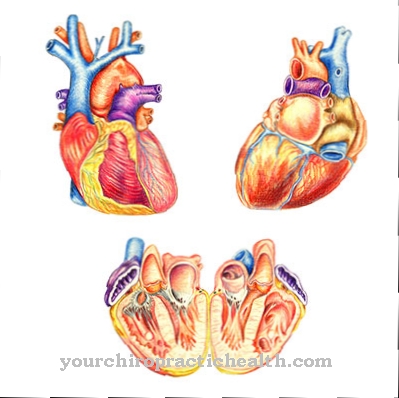The Churg-Strauss syndrome is an inflammatory disease of the small blood vessels and belongs to the group of rheumatic diseases.Today it is also called in medicine eosinophilic granulomatosis with polyangiitis (EGPA) designated. The original name goes back to the two American pathologists Jacob Churg and Lotte Strauss.
What is Churg-Strauss Syndrome?

© designua - stock.adobe.com
In this disease, the arteries and veins at the end of the bloodstream are primarily affected and have permanent foci of inflammation. Churg-Strauss syndrome is a primary vasculitis (inflammation of the blood vessels); there is no other underlying physical disease that causes this inflammation of the blood vessels.
The consequence of the constant inflammatory activity in the vessels is that the organs behind the diseased vessels are no longer adequately supplied with blood and therefore no longer with sufficient oxygen. Damage therefore occurs primarily to the heart and lungs, but also to other internal organs, as well as to the skin and nerves.
causes
Churg-Strauss syndrome occurs primarily in patients who already suffer from asthma or another allergy. In addition to the asthmatic symptoms, granulomas develop, that is, nodular inflammatory cells accumulate in the small vessels of the lungs and skin. These arise when the body's own immune system turns against protein components of the blood vessel cells, fends them off with the help of leukocytes and destroys them.
This process is known as the autoimmune reaction. The immune system turns against the body's own components and destroys them. In the vessel itself, the body's autoimmune reaction leads to an inflammatory swelling of the vessel wall, which can completely close the vessel.
As a result, the adjacent organs can no longer be supplied with sufficient oxygen and nutrients. This is particularly dangerous in the heart arteries, as an occlusion of these can lead to a heart attack and thus death.
Symptoms, ailments & signs
The symptoms of Churg-Strauss syndrome are rather unspecific at the beginning. Most patients first experience allergic asthma, combined with an allergic runny nose. In the further course it comes to pneumonia with fever. If the heart is affected by the foci of inflammation in the surrounding vessels, this manifests itself in cardiac output weakness which, if the inflammatory vessel is completely blocked, can lead to a heart attack.
Since the disease also damages individual nerve cells in many patients, numbness and paralysis can develop in the affected area. If the area around the stomach and intestines is affected, abdominal pain and diarrhea can occur. In the skin area, the disease manifests itself in the form of ulcers and poorly healing, open wounds.
diagnosis
If asthmatics suffer from other symptoms such as heart failure, pneumonia, recurring sinus infections, sores and bleeding on the skin, the doctor will arrange further examinations. For this purpose, tissue samples are taken from the affected areas of skin or organs and examined.
Furthermore, an increased proportion of eosinophils, a subgroup of white blood cells, can be found in the blood. In addition, in almost half of the patients suffering from Churg-Strauss syndrome, certain antibodies can be detected that are directed against their own body structures.
In general, the laboratory results of the blood test show increased inflammation values. With the help of X-rays, computed tomography and magnetic resonance imaging, foci of inflammation can be found in the heart, lungs or the paranasal sinuses.
Complications
Patients with Churg-Strauss symptoms suffer from constant inflammatory activity of the medium and small arteries and veins that destroy the affected vessels. The result is an insufficient supply of blood to the organs located behind the damaged areas. Serious complications arise when the heart and lungs are affected.
Damage to the kidneys, nerves, intestines and skin is also possible. The vascular inflammation is not based on any other diseases that cause additional complications. However, patients with allergies, especially those with allergic asthma, belong to the risk group.
The use of certain medications can also lead to the complications of this vascular disease. Characteristic for the Churg-Strauss syndrome is the accumulation of inflammation points in the form of nodules, which are known as granulomas. This creates an autoimmune disease with which the body's own defense system is directed against individual components of the body.
The foci of inflammation multiply and cause vascular occlusion. In addition to allergic asthma, patients suffer from runny nose, breathing difficulties and chest pain. Mild pneumonia with fever may occur. Diarrhea, weight loss and abdominal pain are symptoms associated with disease of the abdominal organs.
If individual nerves are damaged, a feeling of numbness develops in the supply area, which leads to symptoms of paralysis. If the heart is involved, the worst case scenario is inflammation of the heart muscle, heart failure or a heart attack. The treatment is medicated.
The survival rate of patients with Churg-Strauss syndrome depends on immediate successful therapy and is 60 percent, whereby the involvement of the heart is crucial.
When should you go to the doctor?
Unfortunately, the Churg-Strauss syndrome does not show any particularly characteristic symptoms, so that an early diagnosis and treatment of this disease is not possible in many cases. A doctor should be seen if the person has a common cold and possibly asthma and other breathing difficulties. Fever and inflammation in the lungs and ears can also indicate the syndrome.
In the worst case, the affected person suffers a heart attack from Churg-Strauss syndrome and can die from it. In the event of a heart attack, immediate medical treatment by an emergency doctor is necessary. Furthermore, numbness or temporary paralysis can indicate the disease.
Wounds that heal poorly or persistent abdominal pain and diarrhea should also be examined by a doctor to avoid further complications. The examination can be carried out by a general practitioner or an ENT specialist. Furthermore, more precise imaging methods are necessary in order to make a conclusive diagnosis.
Doctors & therapists in your area
Treatment & Therapy
The disease is initially treated exclusively with antibiotics. Thereafter, corticosteroids are usually prescribed in low doses. These have an anti-inflammatory effect and are therefore mainly used for rheumatic diseases. The aim of the treatment is to preserve all organ functions by suppressing the signs of inflammation and thus normalizing the blood values.
If the heart or the peripheral nervous system is affected in Churg-Strauss syndrome, an immunosuppressant is administered by the doctor. If left untreated, the disease leads to the further spread of inflammation in the body's vessels and thus harbors the risk of the oxygen supply to vital body cells and organs being blocked and blocked. In order to identify relapses at an early stage, close-knit controls are always necessary.
The earlier a relapse is detected, the faster the doctor can intervene with less aggressive medication. If, after a long-term improvement, rheumatic complaints, increasing asthma and a general feeling of illness occur, these can be warning symptoms for a relapse.
Since Churg-Strauss syndrome is a rare inflammatory immune disease, educating patients and relatives is a particularly important part of therapy. Patient education for vascular diseases is offered by various medical centers or the regional associations of the Rheumaliga.
As the diagnosis of the disease often means a major turning point in social, professional and family terms for those affected and their relatives, competent and holistic medical care is indicated. Sometimes psychotherapy may also be necessary in order to deal with the diagnosis and the consequences of the disease.
The survival rate of those affected over a five-year period is 60 percent. Here it plays a major role whether the vessels of the heart are affected by foci of inflammation.
Outlook & forecast
The Churg-Strauss syndrome does not heal itself. As a rule, the symptoms only worsen if they are not treated, and in the worst case, they can lead to the death of the person concerned. Those affected suffer from fever and pneumonia, which can also lead to other inflammations in the body. As it progresses, Churg-Strauss syndrome can also lead to a heart attack if it is not treated properly. The patients often feel numbness, severe abdominal pain or even diarrhea.
If the syndrome is not treated, wound healing is significantly delayed and permanent paralysis continues. In most cases, Churg-Strauss syndrome can be treated well with the help of medication. The course of the disease is positive, although those affected are dependent on long-term use of immunosuppressants. If left untreated, Churg-Strauss syndrome can lead to further inflammation.
Even after successful treatment, patients are dependent on regular examinations in order to detect a relapse early on. Whether the life expectancy of the person affected is reduced by the syndrome depends heavily on whether the heart is also affected by the disease or not.
prevention
Since Churg-Strauss syndrome is an inflammatory rheumatic autoimmune disease that is not based on any other primary disease, no preventive measures can be taken. A healthy and balanced lifestyle with a balanced diet and physical activity is important for patients. It is also important for those affected to know about the warning signs of a relapse in order to then seek medical treatment accordingly.
Aftercare
Eosinophilic granulomatosis with polyangitis (EGPA), formerly known as Churg-Strauss syndrome, occurs relatively rarely. The syndrome has three phases. Depending on the age at which phase one occurs and when the correct diagnosis is made, treatment and follow-up care are coordinated.
Here it is important to consider both the aftercare from phase one and the development to the second phase of the disease. In this sense, aftercare measures often also include preventive measures. However, several years can elapse between the development of individual phases of eosinophilic granulomatosis with polyangitis (EGPA). In this respect, follow-up care can be possible in every phase of the disease if the distance is greater.
The problem is the relatively short average survival time between diagnosis and phase three without medical treatment. If left untreated, 25 percent of those affected survive at best. For medically treated sufferers, the survival rate is 75 percent. The risk of severe cardiovascular disease is greatly increased by vasculitis. That alone requires careful follow-up care.
Monitoring of corticosteroid therapy is necessary. In addition, in severe cases of Churg-Strauss syndrome, chemotherapeutic agents, interferon, immunoglobulins or procedures such as plasmapheresis can be used. Such treatment approaches also require monitoring and follow-up measures because of severe side effects and after-effects. Since new preparations are also being tested for Churg-Strauss syndrome, clinical studies help to provide a better understanding.
You can do that yourself
Churg-Strauss syndrome is a very rare inflammatory immune disease. Educating patients and their relatives is therefore an important part of therapy. There are a number of clinics, health centers, and health insurance companies that offer training on vascular disease. The regional associations of the Rheuma-Liga are also involved in this area.
The chances of recovery for the patient are higher, the earlier the disease is recognized and treated. If the inflammatory processes are so advanced that severe damage to the lungs and heart has occurred, the chances of survival drop drastically. The best self-help measure is therefore to consult a competent doctor as soon as possible. In the early stages, the syndrome resembles an allergic runny nose or mild asthma. Anyone who observes such symptoms again and again without knowing the causes should not trivialize these symptoms, but rather have them clarified by a doctor as soon as possible.
As part of the treatment of Churg-Strauss syndrome, antibiotics are regularly prescribed. Because these drugs also kill beneficial bacteria in the intestines, very severe diarrhea often occurs. Those affected can prevent these often very stressful side effects by consuming probiotic foods such as yoghurt. The direct intake of bacterial cultures is much more effective. Corresponding preparations are available in pharmacies and health food stores.
In naturopathy, a change in diet, especially a vegetarian diet without milk and dairy products, is recommended for inflammatory immune diseases.


.jpg)

.jpg)








.jpg)

.jpg)
.jpg)











.jpg)